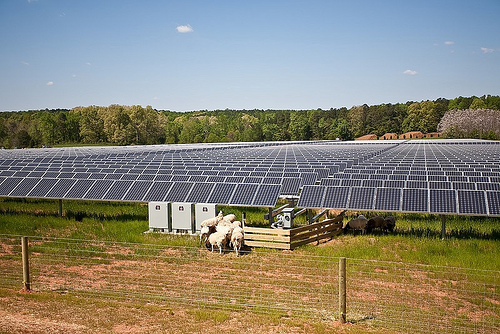Solar Energy Applications for Farms and Ranches
Warning: Undefined variable $tagger in /var/www/bioenergypro.com/public_html/bioenergy-articles/snews.php on line 2924
Warning: Undefined array key "https://www.bioenergypro.com/bioenergy-articles/Logged_In" in /var/www/bioenergypro.com/public_html/bioenergy-articles/snews.php on line 2999
Solar energy can be used on farms and ranches to meet and/or supplement many energy requirements.

Space and Water Heating
Livestock and dairy operations often have substantial air and water heating requirements. Modern pig and poultry farms raise animals in enclosed buildings, where it is necessary to carefully control temperature and air quality to maximize the health and growth of the animals. These facilities need to replace the indoor air regularly to remove moisture, toxic gases, odors, and dust. Heating this air, when necessary, requires large amounts of energy. With proper planning and design, solar air/space heaters can be incorporated into farm buildings to preheat incoming fresh air. These systems can also induce or increase natural ventilation levels during summer months.
Solar water heating systems can provide low to medium temperature hot water for pen cleaning. Commercial dairy farms use large amounts of energy to heat water to clean equipment, as well as to warm and stimulate cows' udders. Heating water and cooling milk can account for up to 40% of the energy used on a dairy farm. Solar water heating systems may be used to supply all or part of these hot water requirements.
Greenhouse Heating
Farms also can use solar energy to heat greenhouses. Commercial greenhouses typically rely on the sun to supply their lighting needs. They usually aren't designed to use the sun for heating. They rely on gas or oil heaters to maintain the temperatures necessary to grow plants in the colder months. Solar greenhouses, however, are designed to use solar energy for both heating and lighting. A solar greenhouse uses thermal mass to collect and store solar heat energy. Its insulation retains this heat for use during the night and on cloudy days.
A solar greenhouse also is oriented to maximize southern glazing exposure. Its northern side has little or no glazing, and is well insulated. To reduce heat loss, the glazing itself is also more efficient than single-pane glass. Various products range from double pane to "cellular" glazing. A solar greenhouse reduces the need for fossil fuels for heating. A gas or oil heater may serve as a back-up heater, or may increase carbon dioxide levels to induce higher plant growth.
Electricity
Solar electric, or photovoltaic (PV), systems can be used on farms and ranches to power electrical fencing, lighting, and water pumping.
When properly sized and installed, PV water pumps are very reliable and require little maintenance. The size and cost of a PV water pumping system depends on the following:
- Local solar resource
- Pumping depth
- Water demand
- System purchase and installation costs.
Most solar electric systems are typically more cost effective in remote locations where there are no existing power lines.
Crop and Grain Drying
Using the sun to dry crops and grain is one of the oldest and most widely used applications of solar energy. The simplest, and least expensive technique is to allow crops to dry naturally in the field, or to spread grain and fruit out in the sun after harvesting. The disadvantage of these methods is that the crops and grain can be damaged by birds, rodents, wind, rain, and contamination by windblown dust and dirt.
More sophisticated solar dryers do the following:
- Protect grain and fruit
- Reduce losses
- Dry faster and more uniformly
- Produce a better quality product than open-air methods.
The basic components of a solar dryer include an enclosure or shed, screened drying trays or racks, and a solar collector. In hot, arid climates the collector may not even be necessary. The southern side of the enclosure itself can be glazed to allow sunlight to dry the material. The collector can be as simple as a glazed box with a dark-colored interior to absorb the solar energy that heats air. The air heated in the solar collector moves, either by natural convection or forced by a fan, up through the material being dried. The size of the collector and rate of airflow depends on the following:
- The amount of material being dried
- The material's moisture content
- The humidity in the air
- The average amount of solar radiation available during the drying season.
There are relatively few large solar crop dryers in the United States. This is because the cost of the solar collector can be high. In addition, drying rates can't be controlled as easily as with natural gas or propane-powered dryers. Using the collector at other times of the year, such as for heating farm buildings, may make a solar dryer more cost-effective. It is possible to make small, very low cost dryers out of simple materials. These systems can be useful for drying vegetables and fruit for home use.
by U.S. Department of Energy
This article hasn't been commented yet.


Write a comment
* = required field